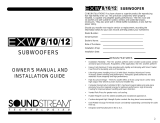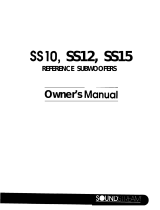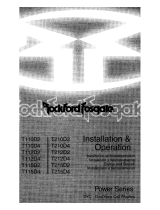Page is loading ...

12
SOUNDSTREAM TECHNOLOGIES
120 Blue Ravine Road • Folsom • California 95630 USA
tel 916.351.1288 fax 916.351.0414
(REV A, 3/2/98)
1
Subwoofers
OWNER'S
MANUAL AND
INSTALLATION GUIDE

2
SPL10, SPL12 AND SPL15 SUBWOOFERS
CONGRATULATIONS! You have chosen a superior product for
reproducing high "Sound Pressure Levels" in the car. This precision
component, when properly installed, is capable of amazing output
performance. The SPL10, SPL12 and SPL15 woofers are extremely high
output speakers with performance made possible through outstanding design
and exceptional quality in parts and construction.
Should your woofer ever require service or replacement, recording the
information below for your own records will help protect your investment.
Model Number:___________________________________________________________
Serial Number: ___________________________________________________________
Dealer’s Name: __________________________________________________________
Date of Purchase: ________________________________________________________
Installation Shop: _________________________________________________________
Installation Date: _________________________________________________________
DESIGN FEATURES
• Long Excursion Designs -- The SPL woofers use high performance components and the
New Ultra-Excursion Surround to achieve extra long excursion for high output and deep
bass.
• Heavy Gauge Steel Baskets provide extra rigidity and damping.
• Silver Powder Coating ensures durability and lasting good looks.
• Ultra-High power handling Voice Coils with Kapton/Epoxy formers increase power
handling and performance. Aerospace grade adhesives and materials insure longevity and
high performance.
• Dual Voice Coil Inputs for increased flexibility in optimizing installations.
• Computer Numerically Controlled (CNC) machined magnet plates and pole piece
precisely focus the magnetic energy for optimum performance.
• High Emissivity Coatings on all steel plates improve power handling.
• Large Magnet Structures for powerful, well-controlled output.
• Vented Pole Pieces for greater voice coil cooling.
• Custom-designed High Strength Spiders control the long travel cone assembly.
11
Vented (V)
Sealed
Bandpass
Sealed (Cont'd)
• 3.0 ft
3
- Good linear
response, excellent
all around enclosure.
Vented
• 2.0 ft
3
@ 50 Hz
(Three 4" x 12.25"
ports) - High output
with good low
frequency extension.
Good small
enclosure.
• 3.0 ft
3
@ 40 Hz
(Three 4" x 13"
ports) - High output
with excellent low
frequency extension.
Great for Rock
music or home
theater applications.
• 4.0 ft
3
@ 30 Hz
(Three 4" x 18.75"
ports) - High output
with low frequency
extension. Great for
Rock music or home
theater applications.
Sealed Bandpass
• Rear = 3.0 ft
3
sealed
• Front = 2.2ft
3
@ 55
Hz (Three 4" x 6.75"
ports) - High output
with good low
frequency extension.
Good for Rock or
Rap.
• Rear = 1.5 ft
3
sealed
• Front = 2.2 ft
3
@
72Hz (Four 4" x 5"
ports) - Very high
50
55
60
65
70
75
80
85
90
95
100
105
110
10 100 1000
Frequency Hz
dB
50
55
60
65
70
75
80
85
90
95
100
105
110
10 100 1000
Frequency Hz
dB
50
55
60
65
70
75
80
85
90
95
100
105
10 100 1000
Frequency Hz
dB
50
55
60
65
70
75
80
85
90
95
100
105
110
10 100 1000
Frequency Hz
dB
50
55
60
65
70
75
80
85
90
95
100
105
110
10 100 1000
Frequency Hz
dB
50
55
60
65
70
75
80
85
90
95
100
10 100 1000
Frequency Hz
dB

10
Sealed (S)
Sealed Bandpass
(SBP)
Sealed
• 1.5 ft
3
- Good linear
response, excellent
small enclosure.
Excellent for high
SPL, multiple driver
applications.
Infinite Baffle
• Excellent performance for all types of music at moderate levels.
Vented (Cont'd)
• 1.0 ft
3
@ 40Hz (4" x
14.25" port) - Small,
versatile enclosure
with good bass.
Great for Rock music
or home theater.
• 1.0 ft
3
@ 50Hz (4" x
8" port) - Small
enclosure with good
punch. Good for Rap
or Rock.
Sealed Bandpass
• Rear = 1.0 ft
3
sealed
• Front = 1.5 ft
3
@ 60
Hz (Three 4" x
11.25" ports) - Very
high output, narrow
response. Good for
Rap, Rock and SPL!
Boomer!
• Rear = 1.0 ft
3
sealed
• Front = 1.0 ft
3
@
55Hz (Two 4" x
14.75" ports) - Great
50
55
60
65
70
75
80
85
90
95
100
10 100 1000
Frequency Hz
dB
50
55
60
65
70
75
80
85
90
95
100
105
10 100 1000
Frequency Hz
dB
50
55
60
65
70
75
80
85
90
95
100
105
10 100 1000
Frequency Hz
dB
50
55
60
65
70
75
80
85
90
95
100
105
110
10 100 1000
Frequency Hz
dB
50
55
60
65
70
75
80
85
90
95
100
105
10 100 1000
Frequency Hz
dB
3
SPL10 SPL12 SPL15
Frequency Response (Hz)
32-500 30-500 25-500
Sensitivity (2.83v/1m)
92 dB 94 dB 95 dB
Impedance (nominal Z, ohms)
2 2 2
Rated Program Power, Watts
250 300 400
Fs (Hz)
33 30 23
Qts
.528 .362 .360
Qms
8.31 4.77 9.22
Qes
.564 .391 .380
EBP (Fs/Qes)
58.5 76.7 60.5
Vas (ft
3
)
1.51 3.20 9.82
Vas (liters)
43 91 278
Vas (m
3
)
.043 .091 .278
Cms (um/N)
267 245 229
DCR (ohms)
1.53 1.53 1.60
Levc (mH) @ 1 KHz
1.2 1.2 1.80
BL (Tesla m)
7.06 9.26 11.20
Sd (in
2
)
52.1 76.0 143
Sd (m
2
)
.034 .049 .092
Sd (cm
2
)
336 490 924
X max; one way (linear mm)
6.6 6.6 7.6
X max; one way (peak mm)
19 21 30
Vd (linear cm
3
)
222 323 702
Vd (peak cm
3
)
638 1029 2772
Vd (linear m
3
)
.000222 .000323 0.000702
Vd (peak m
3
)
.000638 .001029 0.002772
Mms (grams)
90.0 118 201
Magnet Assembly (oz)
136 172 238
Magnet Weight (oz)
42 58 100
Vf (volume of frame, in
3
)
135 200 320
Coil length (mm)
23
23
27.9
SPECIFICATIONS & THIELE/SMALL PARAMETERS

4
SELECTING AN ENCLOSURE
There are several different enclosure designs for different applications.
The SPL subwoofers work very well in all of the following enclosure
designs. It is up to you to select the specific enclosure that will work
the best for your particular application.
Infinite Baffle
Infinite baffle is the simplest type of subwoofer installation. In this type
of installation, the woofer(s) is mounted to a baffle which is then
mounted to either the rear deck or back seat of the vehicle. The best
results are achieved when the trunk area is virtually airtight and
isolated from the passenger compartment.
Sealed Enclosure
Sealed enclosures are relatively simple to build and install, as all that is
required is an airtight box. The larger the sealed enclosure, the more
the performance resembles that of an infinite baffle installation.
Vented Enclosure
Vented enclosures use a sealed enclosure with a vent or port in the box
which is tuned to resonate at a specific frequency.
Pros Cons
• Good low frequency exten-
sion down to the tuning fre-
quency
• High power handling down
to the tuning frequency
• Higher output than sealed
enclosures
• Low power handling
below the tuning fre-
quency
• Almost no output be-
low the tuning fre-
quency
Pros Cons
• Very good low frequency ex-
tension
• Very good transient re-
sponse
• High power handling
• Medium efficiency
Pros Cons
• Excellent low frequency extension
• Excellent transient response
• Uses almost no trunk space
• Lower power handling
• Low to medium efficiency
Vented (V)
Sealed (S)
9
Sealed Bandpass
(SBP)
Sealed (S)
Sealed Bandpass
• Rear = 1.5 ft
3
sealed
• Front = .75 ft
3
@ 48
Hz (4" x 13" port) -
High output with
good low frequency
extension. Good for
Rock or Rap.
• Rear = .5 ft
3
sealed
• Front = .75 ft
3
@
66Hz (4" x 5.25"
port) - Very high
output. Great for
Rap music.
50
55
60
65
70
75
80
85
90
95
100
10 100 1000
Frequency Hz
dB
50
55
60
65
70
75
80
85
90
95
100
105
10 100 1000
Frequency Hz
dB
Infinite Baffle
• Excellent performance for all types of music at moderate levels.
Sealed
• .5 ft
3
- Good linear
response, excellent
small enclosure.
Excellent for high
SPL, multiple driver
applications.
• 1.0 ft
3
- Good linear
response, excellent
all around enclosure.
Vented
• 1.5 ft
3
@ 33Hz (4" x
14" port) - Deep
bass, flat response.
Good small
enclosure.
50
55
60
65
70
75
80
85
90
95
100
10 100 1000
Frequency Hz
dB
50
55
60
65
70
75
80
85
90
95
100
10 100 1000
Frequency Hz
dB
Vented (V)
50
55
60
65
70
75
80
85
90
95
100
105
10 100 1000
Frequency Hz
dB

8
SUGGESTED ENCLOSURES
Infinite Baffle
Sealed
• .5 ft
3
- Good linear
response, excellent
small enclosure.
Excellent for high
SPL, multiple driver
applications.
• 1.5 ft
3
- Good linear
response, excellent
all around enclosure.
Vented
• .75 ft
3
@ 50 Hz (4" x
11.5" port) - High
output. Good small
enclosure.
• 1.0 ft
3
@ 40 Hz (4" x
14.25" port) - High
output with good low
frequency extension.
Great for Rock
music.
Vented (V)
Sealed (S)
50
55
60
65
70
75
80
85
90
95
100
10 100 1000
Frequency Hz
dB
50
55
60
65
70
75
80
85
90
95
100
10 100 1000
Frequency Hz
dB
50
55
60
65
70
75
80
85
90
95
100
105
10 100 1000
Frequency Hz
dB
50
55
60
65
70
75
80
85
90
95
100
105
10 100 1000
Frequency Hz
dB
5
Sealed Bandpass Enclosure
Sealed bandpass enclosures enclose both sides of the
woofer(s). An airtight enclosure is built around the front and back of
the woofer and one chamber is ported to a specific frequency.
CALCULATING (NET) INTERNAL ENCLOSURE VOLUMES
When constructing any type of enclosure, you must be aware that the
outside dimensions DO NOT represent the true (Net) volume inside.
Such things as woofers, ports, thickness of enclosure material, dividing
walls, and any internal bracing will reduce the total amount of the
actual air space available. The following worksheet has been designed
to provide you with the necessary steps to accurately calculate the
absolute (Net) internal volume of any given enclosure.
Calculating Cylindrical Port Volume
1. Measure the outside diameter of the port and divide by 2 for the
radius.
2. Square the radius and multiply by 3.14 (π) to arrive at outside port
area.
3. Multiply the area by the length of
the port inside the enclosure for the
port volume.
outside
diameter
length inside
enclosure
Pros Cons
• High power handling
within the operating fre-
quencies
• Very high output within
the range of the operat-
ing frequencies
• Low power handling
beyond the tuning fre-
quency
• Poor to moderate
transient response
• Poor low frequency
extension
Sealed Bandpass
(SBP)

6
Measure maximum possible dimensions
Multiply wall thickness by 2
Subtract this from each dimension to
arrive at Gross Internal Dimensions
Multiply LxWxD to arrive at
Gross Internal Volume
Deduct Vf (volume of the speaker frame)
from Gross Internal Volume
Braces?
No Yes
Calculate brace volume and deduct
from Gross Internal Volume
Deduct Vf (volume of the speaker frame)
from Gross Internal Volume
You are at Net Internal Volume
in cubic inches (in )
3
To convert to LITERS:
Divide in by 61.03
To convert to CUBIC FEET:
Divide in by 1728
3
3
ENCLOSURE VOLUME FLOWCHART
7
BUILDING THE ENCLOSURE
• Determine the dimensions of your enclosure.
• Be certain the box you have designed will fit into the location you have
chosen. Sometimes making a cardboard box with the same outside
dimensions is helpful.
• Use 3/4 inch thick Medium Density Fiberboard (MDF) or High Density
Particleboard. It is preferable to cut the wood with a table saw to ensure
straight, even joints. If a table saw is not available, a circular saw is
acceptable.
• Use a “T” square to verify precise right angle gluing.
• Use a high quality wood glue and air nails or wood screws to assemble the
enclosure. Elmer’s woodworker’s glue and Weldwood work well. To
guarantee an airtight box, seal each inside joint with silicone sealant.
• For Sealed Enclosures, stuff the chamber with 50-75% filling (approximately
1.5 pounds per cubic foot) of fiberglass insulation or Dacron.
• For Vented Enclosures, staple 1 inch thick fiberglass insulation or Dacron to
all walls of the enclosure except the baffle to which the woofer is mounted.
• Use the supplied gasket to seal the woofer in the enclosure and eight(8)
wood screws or T-nuts and bolts. Progressively tighten each of the bolts or
screws to prevent warping the woofer frame.
• Use slide-on connectors to attach speaker wires. Do not solder wires to the
SUGGESTED ENCLOSURES
The following designs include a variety of enclosure sizes and types.
Each design has two frequency response curves; one showing predicted
“In-Car” response, and the other showing “Half-Space Anechoic” (out-of-car)
frequency response. The performance difference between the two curves is a
result of the natural acoustics of an “average” automotive environment. This
“average” transfer function is only an approximation of what you may expect to
see in your car. Every car is different. Each curve was generated using 2.83
Volts across both voice coils in parallel and measured at 1 meter. Also, each
frequency response curve includes a 12 dB/octave low pass at 100 Hz for
sealed and vented enclosures and 200 Hz for bandpass enclosures. The
response curves can help you visualize relative performance differences
between designs. Read through the descriptions given for each enclosure and
select the one that suits your needs.
Remember: all suggested enclosure volumes are Net, and DO NOT include
woofer, port, and bracing displacement!
/




